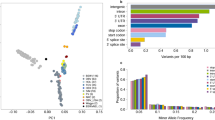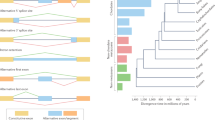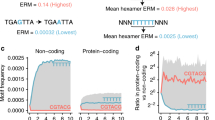Abstract
One of the most interesting opportunities in comparative genomics is to compare not only genome sequences but additional phenomena, such as alternative splicing, using orthologous genes in different genomes to find similarities and differences between organisms1,2. Recently, genomics studies have suggested that 40–60% of human genes are alternatively spliced3,4,5,6,7,8 and have catalogued up to 30,000 alternative splice relationships in human genes9. Here we report an analysis of 9,434 orthologous genes in human and mouse, which indicates that alternative splicing is associated with a large increase in frequency of recent exon creation and/or loss. Whereas most exons in the mouse and human genomes are strongly conserved in both genomes, exons that are only included in alternative splice forms (as opposed to the constitutive or major transcript form) are mostly not conserved and thus are the product of recent exon creation or loss events. A similar comparison of orthologous exons in rat and human validates this pattern. Although this says nothing about the complex question of adaptive benefit, it does indicate that alternative splicing in these genomes has been associated with increased evolutionary change.
This is a preview of subscription content, access via your institution
Access options
Subscribe to this journal
Receive 12 print issues and online access
$209.00 per year
only $17.42 per issue
Buy this article
- Purchase on Springer Link
- Instant access to full article PDF
Prices may be subject to local taxes which are calculated during checkout




Similar content being viewed by others
References
Tatusov, R.L., Koonin, E.V. & Lipman, D.J. A genomic perspective on protein families. Science 278, 631–637 (1997).
Brett, D., Pospisil, H., Valcarcel, J., Reich, J. & Bork, P. Alternative splicing and genome complexity. Nat. Genet. 30, 29–30 (2002).
Mironov, A.A., Fickett, J.W. & Gelfand, M.S. Frequent alternative splicing of human genes. Genome Res. 9, 1288–1293 (1999).
Brett, D. et al. EST comparison indicates 38% of human mRNAs contain possible alternative splice forms. FEBS Lett. 474, 83–86 (2000).
Croft, L. et al. ISIS, the intron information system, reveals the high frequency of alternative splicing in the human genome. Nat. Genet. 24, 340–341 (2000).
International Human Genome Sequencing Consortium. Initial sequencing and analysis of the human genome. Nature 409, 860–921 (2001).
Kan, Z., Rouchka, E.C., Gish, W.R. & States, D.J. Gene structure prediction and alternative splicing analysis using genomically aligned ESTs. Genome Res. 11, 889–900 (2001).
Modrek, B., Resch, A., Grasso, C. & Lee, C. Genome-wide analysis of alternative splicing using human expressed sequence data. Nucleic Acids Res. 29, 2850–2859 (2001).
Xu, Q., Modrek, B. & Lee, C. Genome-wide detection of tissue-specific alternative splicing in the human transcriptome. Nucleic Acids Res. 30, 3754–3766 (2002).
Wheeler, D.L. et al. Database resources of the National Center for Biotechnology Information: 2002 update. Nucleic Acids Res. 30, 13–16 (2002).
Batzoglou, S., Pachter, L., Mezirov, J.P., Berger, B. & Lander, E.S. Human and mouse gene structure: comparative analysis and application to exon prediction. Genome Res. 10, 950–958 (2000).
Green, P. et al. Ancient conserved regions in new gene sequences and the protein databases. Science 259, 1711–1716 (1993).
Hastings, M.L. & Krainer, A.R. Pre-mRNA splicing in the new millennium. Curr. Opin. Cell. Biol. 13, 302–309 (2001).
Britten, R.J. Rates of DNA sequence evolution differ between taxonomic groups. Science 231, 1393–1398 (1986).
Cui, Y., Wong, W.H., Bornberg-Bauer, E. & Chan, H.S. Recombinatoric exploration of novel folded structures: a heteropolymer-based model of protein evolutionary landscapes. Proc. Natl. Acad. Sci. USA 99, 809–814 (2002).
Schuler, G. Pieces of the puzzle: expressed sequence tags and the catalog of human genes. J. Mol. Med. 75, 694–698 (1997).
Needleman, S.B. & Wunsch, C.D. A general method applicable to the search for similarities in the amino acid sequence of two proteins. J. Mol. Biol. 48, 443–453 (1970).
Lee, C., Grasso, C. & Sharlow, M. Multiple sequence alignment using partial order graphs. Bioinformatics 18, 452–464 (2002).
Acknowledgements
We wish to thank D. Black and M. Ares for discussions developing the hypothesis that alternative splicing can facilitate evolutionary tunneling and C. Brunk, G. Chanfreau, J. Lake, A. Resch, Y. Xing, Q. Xu and L. Zipursky for their discussions and comments on this work. C.J.L. was supported by grants from the US National Institutes of Health and U.S. Department of Energy. B.M. was supported by an IGERT award from the National Science Foundation.
Author information
Authors and Affiliations
Corresponding author
Ethics declarations
Competing interests
The authors declare no competing financial interests.
Rights and permissions
About this article
Cite this article
Modrek, B., Lee, C. Alternative splicing in the human, mouse and rat genomes is associated with an increased frequency of exon creation and/or loss. Nat Genet 34, 177–180 (2003). https://doi.org/10.1038/ng1159
Received:
Accepted:
Published:
Issue Date:
DOI: https://doi.org/10.1038/ng1159
This article is cited by
-
Pathological insights from amyotrophic lateral sclerosis animal models: comparisons, limitations, and challenges
Translational Neurodegeneration (2023)
-
Identification and characterization of alternative splicing variants of buffalo LXRα expressed in mammary gland
Scientific Reports (2022)
-
RNA-seq Analysis Reveals Alternative Splicing Under Heat Stress in Rainbow Trout (Oncorhynchus mykiss)
Marine Biotechnology (2022)
-
PIC-Me: paralogs and isoforms classifier based on machine-learning approaches
BMC Bioinformatics (2021)
-
Gene expression and alternative splicing dynamics are perturbed in female head transcriptomes following heterospecific copulation
BMC Genomics (2021)



